We’ve all been there: one week you have more tasks than you can possibly accomplish, and the next, you’re twiddling your thumbs and mindlessly scrolling Twitter. Wouldn’t it be so much better if you and your team had consistent work every week? No more feast or famine. Just a regular, balanced workload that plays to everyone’s strengths.
Allow us to introduce you to workload planning: a concept that helps you reach that balance for your project team and reap all the benefits that come along with it. In this blog, we’ll take you through the process of successful workload planning, step-by-step. We’ll then introduce you to monday work management, a platform that will give you all the tools to build a more effective workflow.
Get startedWhat is workload planning?
Workload planning, sometimes called workload management, is a strategic approach to maximizing your team’s productivity to ensure you reach your goals. It’s essentially the process of breaking down a team’s tasks and scheduling them in an efficient way so work is evenly and intentionally distributed.
You often start by assigning asks based on team member capacity, skill level, and area of specialization. You’ll also consider factors like time off, and hours needed for administrative or non-project tasks.
Workload planning is an active process. You’ll need to regularly review and revise your workload allocation as your project evolves or your team dynamics change. But managing your team’s workload according to this approach immediately solves a few common business problems.
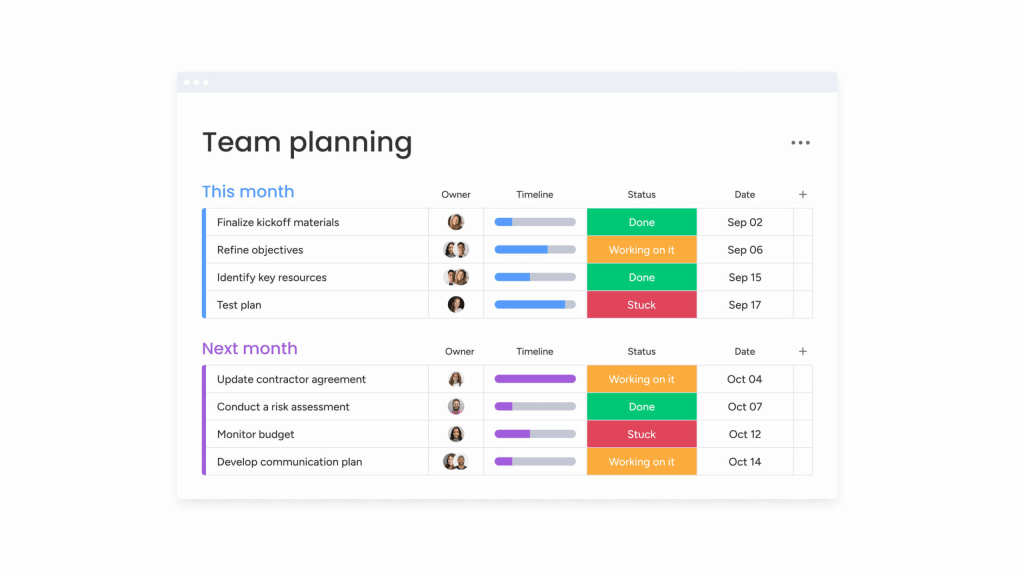
A workload plan template can help you start understanding your team’s current workload and how to assign tasks in order to balance them. You can use it with project management features and tools, too.
Get startedWhat does workload planning include?
Workload planning is an iterative process that includes:
1. Scheduling: actively mapping out goals and project due dates to create a specific, achievable and timely plan.
2. Allocating ownership and resources: assigning tasks to specific employees based on their existing capacity, strengths, and capabilities. This ensures work is evenly spread work amongst different workers so nobody is overwhelmed.
3. Monitoring workload: consistently checking in to see if the original plan is working. Have there been changes in the project scope? Have unexpected situations come up? Adjust your plan accordingly.
What are the benefits of workload planning?
Workload planning benefits your entire business. Here are just some of the many benefits workload planning can bring to your organization:
- Reduce employee stress and burnout: 47% of employees who report burnout attribute it to their workload. Workload planning empowers you to avoid employee burnout before it becomes a problem, by ensuring consistent, reasonable work amongst all workers.
- Give managers insights into the team’s work: Reviewing your team’s current workload lets you identify your top performers — and your underachievers. You’ll also find ways to optimize your workload allocation to get everyone performing at similar levels.
- Improve employee satisfaction and engagement: 58% of employees aren’t totally satisfied with their day-to-day workflow, leaving them less engaged and less productive. With workload planning, you can play to your employee’s strengths and interests when planning their tasks.
- Mitigate errors: When you assign tasks based on skillset, you can make sure the highest-priority work is done by the employee best suited to handle it. You’ll better match tasks to specific skills across the board.
- Provide a single source of truth: Setting clear task assignments, ownership, and deadlines fills any communication gaps between employees and workers.
- Enhances productivity: Above all, workload planning does wonders for your team’s productivity.
To achieve all of this — particularly improved communication — it’s smart to use a workload management tool, like monday work management.
How to track your team’s workload with workload planning software
Workload planning consists of just a few simple steps, but it isn’t always a simple process. Finding the right balance of resources and tasks among your team can take some practice. You’ll need to consider a lot of factors that might change unexpectedly.
Although workload planning can be complex at times, if you follow these steps — and use a workload management tool — you’ll have a solid foundation from which you can test and optimize your team’s workload.
1. Make a list of everything your team needs to do
The very first step in workload planning is to get a complete picture of your team’s actual workload for the upcoming project — or some other appropriate time period, depending on how your team operates. Think through every task your team needs to accomplish in your time frame. This list should include everything from high-priority and specialized tasks, to admin tasks or general work items like checking email or attending meetings.
If you’re already using a team task management tool, like the one below built on a monday.com template, that’s a great starting point for a task list.
Don’t be afraid to ask your team for insight on what other tasks they complete on a daily or weekly basis. You want your task list to be as complete as possible before you begin assigning work.
2. Consider each team member’s work capacity
Now that you have your list of tasks, you’ll need to determine how much time your team has to work on them. First, make a list of the total amount of time your employees are expected to work over the course of your project. Are they in the office 8 hours a day? More?
Then, find the true number of working hours for each employee by accounting for any upcoming time off, lunch or other breaks, regular meetings, and so on. This will help you make sure employees actually have time to complete their tasks. Lastly, consider any particular skills or strengths your employees might have. This could be rapport with a particular client, a specialized industry background, or anything that might make them more adept at one task over another.
While you don’t have to cater to every single strength or preference of your team, doing that as much as possible leads to higher-quality work and more engaged employees. It’s a win-win for everyone.
3. Assign tasks to team members
Start bringing everything together by assigning tasks. Assign the highest-priority work first, allocating them to the team member best suited for each task in light of the capacity and strengths you outlined in the previous step.
To make this as easy as possible, use a resource allocation template or similar layout from monday work management. In the one below, you can assign tasks across projects and assign task statuses or due dates.
You most likely won’t do this perfectly the first time. You’ll need to switch tasks or make changes due to employee needs, project scope changes, or any number of other things. But with a solid baseline, making those adjustments will be a lot easier.
4. Use a workload planning tool to visualize your team’s work
Spreadsheets or other manual processes are wildly inefficient at workload planning. When you make one change, it’s difficult to be sure you’ve updated everything the change has impacted.
A workload planning tool, on the other hand, helps you to be more productive and plan work faster. In fact, when people use an online tool to manage their work, they’re twice as likely to say their company is highly efficient.
Platforms like monday work management allow you to build resource allocation views to see if your team’s workload is balanced. It appears in a handy visual representation like this one:
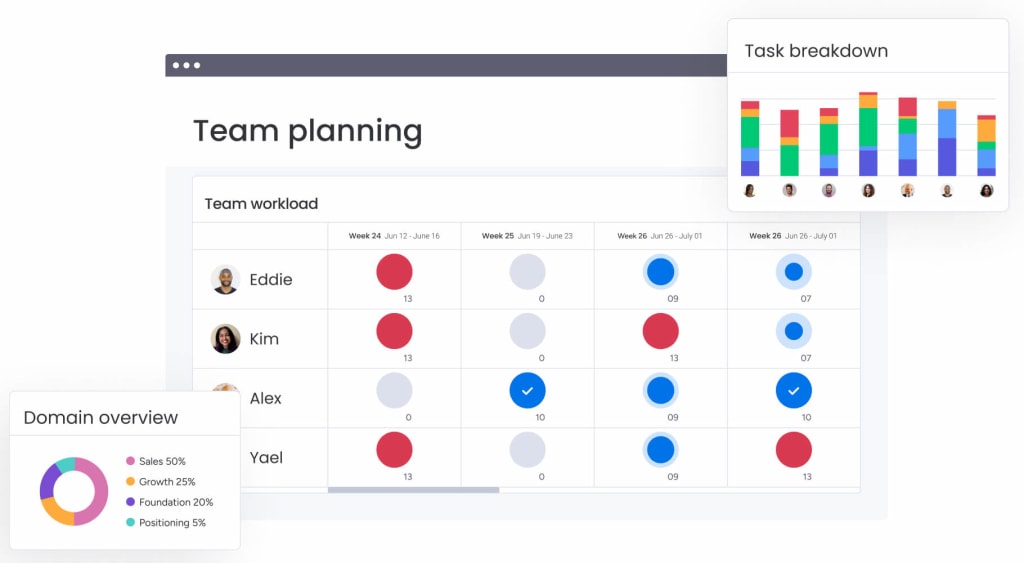
As things progress or change, you’ll be able to drag-and-drop tasks to different due dates or team members to balance workloads. Everything will be updated instantly, and your entire team will always be on the same page. That means everyone can immediately get a precise update on their projects — something 47% of people say they find difficult.
5. Check-in regularly and review with your team
Make sure your team understands and can follow through with your workload plan. Give them an opportunity to present any concerns or conflicts with tasks they’ve been assigned, and make any adjustments you feel are warranted. Keep in mind that your work plan is a living document. As the scope changes, new tasks emerge, or any number of other factors come into play, you’ll need to review and check-in with your team again to reduce the risk of burnout.
Communication like this is key to engaging employees and mitigating stress. Which is important for a happy workplace. 73% of workers say feeling valued and engaged makes them care more about work, while 67% say it motivates them to go above and beyond their duties.
It’s clear: proper workload management is one of the best ways to improve an employee’s work experience while also improving productivity.
What are some techniques for workload planning?
Workload planning requires specific skills, such as:
Project Breakdown
Effective workload planning starts by breaking down larger projects into smaller, manageable tasks. It’s easier to estimate how long each task will take, giving you a more realistic overview of the size of each project.
Breaking down projects into smaller tasks also means you can distribute projects across multiple team members more easily, instead of dumping a giant project on one person.
Task Sequencing
Once you’ve broken down a project into tasks, you need to plan out those tasks across time. You also need to identify task dependencies (e.g. which task needs to happen first?), then put them into a sequence. This helps you avoid bottlenecks and last-minute task pile-ups at the end of projects.
Gantt charts can be a helpful way to visualize task sequencing, and see how the component parts of a project fit together over time.
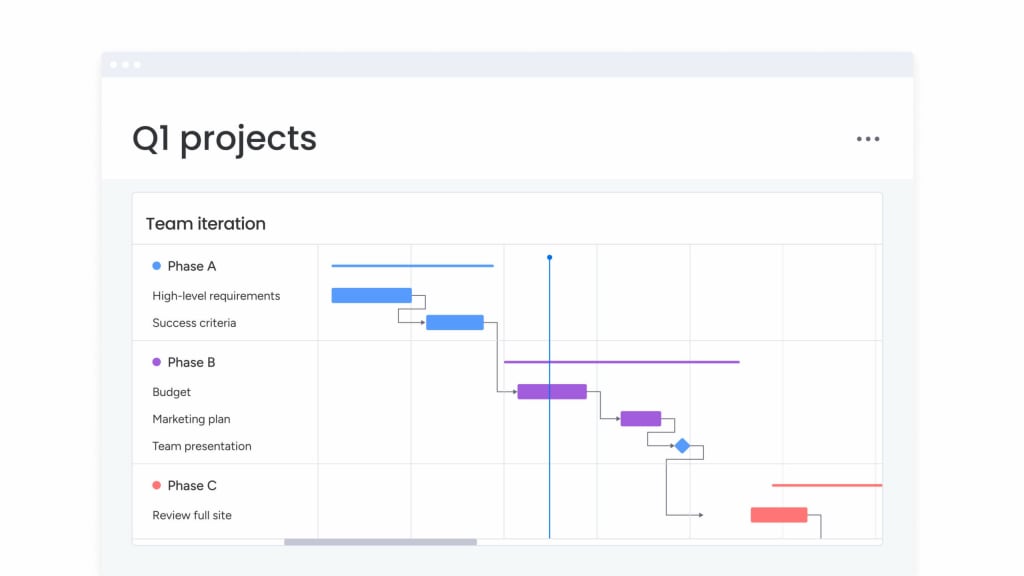
Capacity Planning
Capacity planning is the process of evaluating the capacity and capabilities of your team, so you can align the workload accordingly. You’ll need to consider factors like:
- Available working hours
- Holidays
- Specific skills required to complete the task
- Competing priorities (for instance, if a team member is working on multiple projects at the same time)
How can monday work management help with workload planning?
monday work management makes workload planning far easier, with helpful features like:
- Project and task management: Identify project objectives, needs, and scope from idea to execution. Then assign tasks to owners, set clear deadlines, and follow the status of individual projects, to be sure that your workload planning pays off.
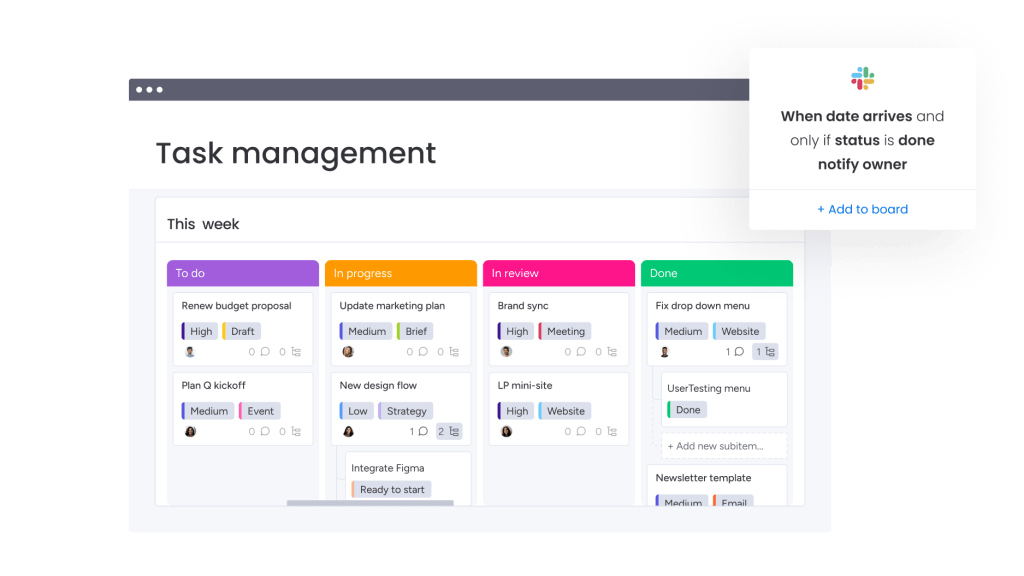
- Automations and templates: Save valuable time and reduce your team’s overall workload, by automating crucial elements of your work — including creating templated project boards, sending approval notifications and reminders, and more.
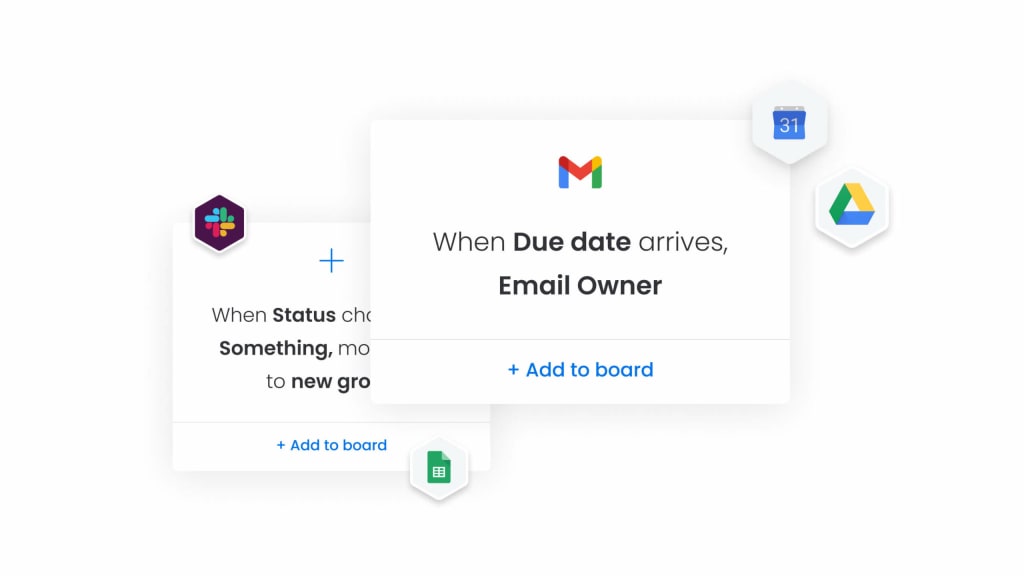
- Integrations and add-ons: Centralize your workload into a single, visual platform, so you have a complete overview of your team’s tasks and projects.
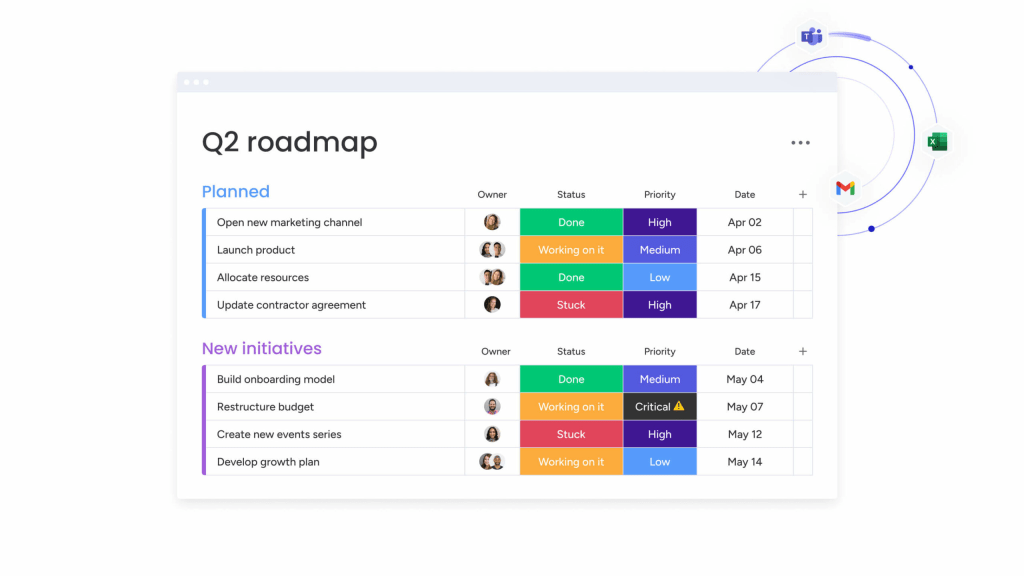
Built on top of monday.com Work OS, monday work management helps you navigate projects, processes, and everyday workload planning with ease, with standardized workflows, easy-to-understand dashboards, and built-in communication tools to keep you all on the same page.
Frequently asked questions about workload planning
1. How do I calculate workload?
A simple formula to calculate basic workload is the following:
Task x time to perform task x frequency
2.What to keep in mind when planning workload?
When planning workload it is important to keep in mind:
- Team capacity
- The possibility for unexpected changes
- Team member strengths
- Project due dates and expectations
3. Is a workload planning software worth it?
A workload planning software makes workload planning as simple, and effective as possible. It allows teams to visualize workloads and resource availability, easily make changes to better plans, and clearly communicate expectations. Most importantly, it provides one central location, making all information available.
Start planning your team’s workload today
Workload planning helps you utilize resources more efficiently across your team or organization. It also helps you to reduce employee stress and burnout and increases engagement and productivity.
When you create a workload planning tool on monday work management, you can connect it to other boards and tools for project management, task management, and so much more.
Try monday work management for a work management experience that helps your entire business.

